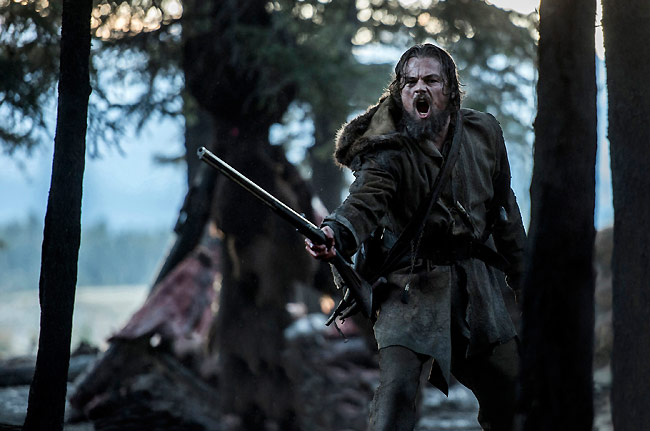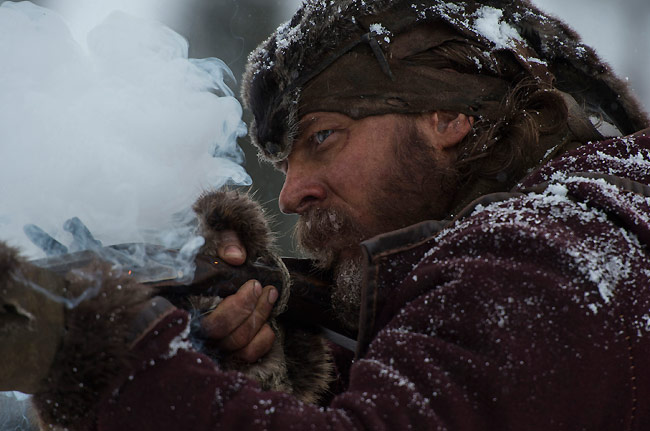
Twentieth Century Fox
revenant
– noun
– a person who has returned, especially supposedly from the dead.
At a time in TV and movie entertainment when the landscape is ripe with zombies, there has been a sub-genre of storytelling involving folks who have been dead for days or years who suddenly return to their daily lives — sans the whole flesh eating hunger. The French television show Les Revenants debuted in 2012 and garnered a cult following on US television. That show begat ABC’s short-lived Resurrection (although the producers claimed there was no connection to the French version … except for the entire premise) and A&E’s even shorter-lived authorized US adaptation The Returned.
Now the big screen is getting in on the act with the latest from Birdman director Alejandro G. Iñárritu. The Revenant tells the “true” story of Hugh Glass, one of a group of fur trapper in 1800s South Dakota. On an expedition, the group is attacked by Indians, with the few survivors looking for a way to get back to their fort. Along the way, Hugh has an unfortunate encounter with a grizzly bear that leaves him gravely wounded, making it nearly impossible to transport him back to safety. The group’s leader, Captain Andrew Henry (Domhnall Gleeson), offers a monetary bonus to any man who will stay with Glass until he finally expires to give him the proper burial.
Young Bridger (Will Poulter) and Glass’ son Hawk (Forrest Goodluck) offer to stay, but the cantankerous John Fitzgerald (Tom Hardy) knows the two would not be able to defend themselves should there be another attack. He also sees dollar signs to help replace the pelts he lost in the earlier attack, so he agrees to stay thinking Glass will be gone within a day or two. But Glass refuses to die, leading Fitzgerald to offer assistance if Glass would simply blink his approval. Quite a sneaking way to finish someone off, and Glass finally can’t not blink after a few minutes. That’s all Fitzgerald needs to try to suffocate him, but Hawk intervenes and gets murdered in the process … as his father watches. Bridger is off getting water, comes back, is told Glass is dead, Hawk is missing and there are 20 (or a dozen) Indians heading their way. Bridger doesn’t want to leave, but he does, not knowing that Glass is just a few feet away barely covered in a shallow grave, with a seething rage that will propel him from the grave and on a mission to exact his revenge.
The Revenant is a difficult film to put into words since so much of it is visual and visceral. Iñárritu’s cinematographer Emmanuel Lubezki captures the vast beauty of the Dakotas (actually Alberta, British Columbia) that will leave you breathless. But against all the pristine beauty of the snow-covered mountains, Iñárritu and Lubezki capture the harsh brutality of the situation as well. And let’s just get right to the film’s most talked-about scene, the bear attack.
Yes, some idiots online have tried to make the attack into something it isn’t, so we’ll just pay them no mind. The scene focuses on Glass stumbling upon some grizzly cubs frolicking in the forest unaware that mama bear is right behind him. Before he can shoot, she is on him biting and mauling him in one of the most horrific, realistic bear attack scenes ever committed to film (with the help of an expert on such things). Even knowing how it was done, I still felt myself on the verge of bursting into tears because it was just that horrifying to watch, filmed as it was in a “single take” (actually many takes expertly stitched together by Iñárritu, editor Stephen Mirrione, and the SPFX team). This is the pinnacle of the brutality of a film that has already staged a bloody Indian attack, and there is more to come. It’s not an easy film to watch, but at the same time it will grip you so much that you will find it hard to turn away.
After Glass is recovered enough to get moving, the film does drag a bit as we follow his trek (with some even more unbelievable adventures that should have killed him), the attempt of the fur trappers to find their way home without him (they do, but after seemingly being lost, they’re suddenly at the fort later with no real explanation), and a tribe of Indians looking for the chief’s daughter, who had been kidnapped by a group of white men. And Glass’ dreamy hallucinations. Some of this traveling could have been trimmed a bit to bring the film closer to two hours (it runs over two-and-a-half now), but in the end it doesn’t diminish the achievements of everyone involved.
Besides all of the monumental technical achievements, from shooting in the snowy wilderness to creating the seamless effects and many “single take” shots, credit has to be given to DiCaprio for really putting himself through the wringer. The bear attack scene is bad enough, but he goes through more and for most of the film he doesn’t even speak since his throat was badly slashed by the bear. And the dialog he does have is some English, some Pawnee. He really gives it his all and you never really stop to think that you’re watching Leo DiCaprio.

Twentieth Century Fox
As good as he is though, Tom Hardy is just as good if not better. Hardy ditches his Brit accent for something a little more American (we’ll assume Texan since that’s where Fitzgerald wants to go) and intelligible, buried under a mess of a beard and some scraggly hair, complete with half of his scalp missing courtesy of a much earlier encounter with “savages.” Hardy makes Fitzgerald an unapologetic villain, and even when he offers to stay with Glass, you know that no good will come of it. From one bad decision to another, all to serve his own purposes, you may find yourself rooting for Glass to do horrible things to him, no matter how much of a Tom Hardy fan you may be. With his terrific performance in last summer’s Mad Max: Fury Road to his awards-hopeful turn as gangster twins in the not-very-good Legend, this role will be the one to actually get Hardy some awards notice (and he’s already been nominated as Best Supporting Actor by the Critics’ Choice Awards).
The Revenant is gripping and difficult to watch, a little over-long, but still a movie to be seen on the big screen. The movie is based on a novel by Michael Punke which is based on the true story of Hugh Glass — although even the “true” account of his story seems highly embellished. Either way, the movie is an expert piece of storytelling that will keep your eyes glued to the screen.


